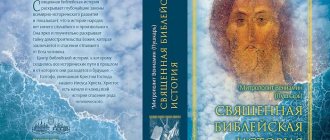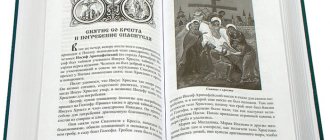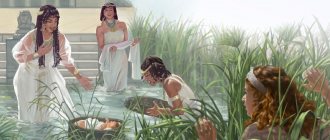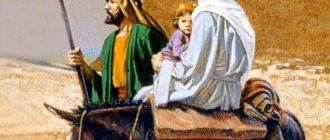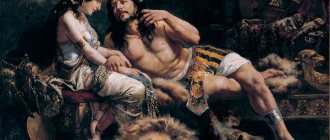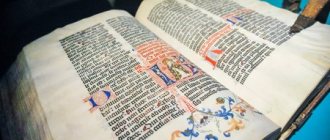Holy Bible story
The book by Professor, Candidate of Theological Sciences, Metropolitan of Vladivostok and Primorsky Veniamin (Pushkar), examines the events of the Holy Biblical history of the Old and New Testaments from the point of view of archaeological and scientific discoveries of the 20th century.
This publication can be recommended to students studying in the fields of “Theology” and “Religious Studies”, Sunday school students, as well as anyone interested in biblical history.
“Sacred Biblical history should rightfully occupy first place among the historical sciences, since it is an inexhaustible source of moral and higher historical education... Sacred Biblical history vividly and instructively reveals the mystery of God’s Economy, which lies in the salvation of man who has fallen away from God,” writes in preface by Metropolitan Benjamin (Pushkar).
Approved for publication by the Publishing Council of the Russian Orthodox Church.
Content:
Part I. THE OLD TESTAMENT Preface - 7 INTRODUCTION - 10 The Holy Bible - Book of Books - 10 The title and contents of the Bible - 14 On the various forms and ways of expressing the meaning of the Holy Scriptures - 18 On the ways of understanding and explaining the meaning of the Holy Scriptures - 23 Summary of the book of Genesis - 26 Chapter 1. CREATION BY GOD OF THE WORLD AND MAN 1.1. Angelic world - 29 1.2. Material world - 31 1.3. Days of creation - 32 ▪ 1.3.1. First day - 32 ▪ 1.3.2. Second day - 35 ▪ 1.3.3. Third day - 36 ▪ 1.3.4. Fourth day - 37 ▪ 1.3.5. Fifth day - 38 ▪ 1.3.6. Sixth day - 38 ▪ 1.3.7. Seventh day - 40 1.4. The creation of the first people and their blissful life in paradise - 41 1.5. The Fall and its consequences - 44 Chapter 2. ANTEDILUDIAN AND POSTFLUDILV HUMANITY 2.1. The human race before the flood. First family. Cain and Abel. The religious and moral state of antediluvian humanity - 48 2.2. Descendants of Cain and Seth - 51 2.3. The Flood - 53 2.4. Descendants of Noah - 58 2.5. Babylonian pandemonium and dispersion of nations - 60 2.6. The beginning of idolatry - 63 Chapter 3. PATRIARCHAL PERIOD IN THE HISTORY OF THE JEWISH PEOPLE 3.1. The calling of Abram and his resettlement to the promised land - 64 3.2. Abram in Egypt - 69 3.3. Abram is separated from Lot. The release of Lot from captivity - 70 3.4. Fourth Epiphany to Abram - 73 3.5. Birth of Ishmael - 74 3.6. Abram receives the name Abraham - 75 3.7. The appearance of God to Abraham at the oak of Mamri. Death of wicked cities - 77 3.8. The birth of Isaac and the expulsion of Hagar - 81 3.9. Sacrificing Isaac to God - 83 3.10. Death of Sarah and marriage of Isaac - 86 3.11. Death of Abraham - 89 3.12. Isaac and his sons - 90 3.13. The trick of Rebekah and Jacob - 92 3.14. Jacob's Ladder - 95 3.15. Life of Jacob by Laban - 97 3.16. Jacob leaves Haran - 100 3.17. Meeting with Esau - 102 3.18. Jacob's further journey to the oak grove of Mamre - 105 3.19. The brothers sell Joseph to the Ishmaelites - 107 3.20. Joseph in Potiphar's house - 110 3.21. Dreams of the Pharaoh - 112 3.22. Joseph's meeting with his brothers - 115 3.23. Joseph reveals himself to his brothers - 119 Chapter 4. THE PERIOD OF THE JEWS' STAY IN EGYPT 4.1. Israel's resettlement in Egypt - 122 4.2. Death of Jacob and Joseph - 123 4.3. The position of the Jews in Egypt after the death of Joseph - 125 Chapter 5. THE BEGINNING OF THE PERIOD OF LEADERSHIP. THE CALLING OF MOSES AND THE EXIT OF THE JEWS FROM EGYPT 5.1. The birth and upbringing of Moses - 128 5.2. The calling of Moses - 132 5.3. Egyptian plagues - 135 5.4. Establishment of Easter - 137 5.5. Exodus from Egypt - 140 5.6. The miraculous passage through the Red (Red) Sea - 142 Chapter 6. THE WAY OF THE JEWS TO SINAI 6.1. Desert Sur - 145 6.2. Sin Desert - 147 6.3. Rephidim - 148 Chapter 7. AT MOUNT SINAI-CHOREB 7.1. Conclusion of the Covenant - 152 7.2. Sinai legislation and its significance - 153 7.3. The covenant is confirmed by sacrificial blood - 156 7.4. Violation of the Covenant - 157 7.5. Restoration of the Covenant - 160 7.6. Construction of a camp temple and its arrangement - 160 7.7. The educational significance of the tabernacle is 163 7.8. Old Testament priesthood - 164 Chapter 8. THE WAY FROM SINAI TO CANAAN 8.1. Coffins of whim - 166 8.2. Asirof - 169 8.3. Paran Desert - 170 Chapter 9. THIRTY-EIGHT YEARS IN THE DESERT 9.1. The indignation of Korah, Dathan and Abiron - 174 9.2. Doubts of Moses and Aaron - 177 Chapter 10. TO THE PROMISED LAND 10.1. Copper serpent - 180 10.2. The further path to the promised land - 181 10.3. The Last Days of Moses - 182 Chapter 11. CONQUEST OF THE PROMISED LAND 11.1. Miraculous crossing of the Jordan River - 187 11.2. Fall of Jericho - 191 11.3. Capture of Guy - 193 11.4. The cunning of the inhabitants of Gibeon - 195 11.5. Battle of Gibeon - 196 11.6. Further conquest and division of the Promised Land - 198 Chapter 12. THE PERIOD OF THE JUDGES (APPROXIMATELY 1200-1025 BC) 12.1. The political situation and religious state of Israel after the death of Joshua - 201 12.2. Deborah and Barak - 204 12.3. Gideon - 207 12.4. Jephthah - 212 12.5. Samson - 214 12.6. High Priest and Judge Eli - 221 12.7. Birth, upbringing and calling to the prophetic ministry of Samuel - 223 12.8. The death of the Elijah dynasty and the captivity of the ark - 225 12.9. Samuel - prophet and judge - 227 Chapter 13. PERIOD OF KINGS (APPROXIMATELY 1040-586 BC) 13.1. Saul's anointing as king - 230 13.2. Saul defeats the Ammonites - 233 13.3. Saul's first disobedience - 235 13.4. Saul's second disobedience - 236 13.5. The anointing of David as king - 238 13.6. Heroic feat of David - 240 13.7. The glory of David and the jealousy of Saul - 243 13.8. Open persecution of David by Saul - 245 13.9. Death of Samuel and Saul - 248 10/13. Reign of David (1010-970 BC) - 250 11/13. Jerusalem - the capital of the kingdom of David - 251 13.12. Expansion and strengthening of the kingdom of Israel - 255 13.13. The moral fall of David - 257 13.14. Absalom's rebellion - 259 13.15. The accession of Solomon and the death of David (970 BC) - 261 13.16. Solomon - a wise judge and ruler - 263 13.17. Construction of the Jerusalem Temple - 266 13.18. Solomon's wealth and his moral fall - 270 13.19. Division of the Jewish kingdom into Judah and Israel (930 BC) - 272 13.20. A brief overview of the history of the kingdom of Israel (930-721 BC) - 274 13.21. A brief overview of the history of the Kingdom of Judah (930-586 BC) - 277 Chapter 14. ACTIVITIES OF THE PROPHETS IN THE KINGDOM OF ISRAEL AND JUDAH 14.1. Prophet Elijah - 284 14.2. Prophet Elisha - 289 14.3. Prophet Jonah - 291 14.4. Prophets Amos and Hosea - 294 14.5. Prophet Isaiah - 296 14.6. Prophet Jeremiah - 298 14.7. Minor prophets in Judea before the Babylonian captivity: Obadiah, Joel, Micah, Nahum, Habakkuk, Zephaniah - 300 Chapter 15. BABYLONIC CAPTIVITY 15.1. “On the rivers of Babylon” - 304 15.2. Prophet Ezekiel - 307 15.3. Prophet Daniel - 309 15.4. Friends of the prophet Daniel in the Babylonian furnace - 312 Chapter 16. PERSIAN RULE (539-333 BC) 16.1. The fall of the Babylonian kingdom - 314 16.2. Prophet Daniel, thrown to the lions - 316 16.3. Return from captivity - 318 16.4. Construction of the second temple - 320 16.5. The activities of the priest Ezra - 322 16.6. The activities of Nehemiah - 324 Chapter 17. THE PERIOD OF GREEK RULE (333-63 BC) 17.1. Judea under the rule of the kings of Egypt. Translation of the Holy Scriptures into Greek - 328 17.2. Judea under the rule of the Syrian kings (199-143 BC) - 330 17.3. The war of liberation led by the Maccabees - 332 Chapter 18. THE RULE OF THE MACCABEAN, OR ASMONEAN, DYNASTY (143-63 BC) - 335 Chapter 19. THE PERIOD OF ROMAN RULE 19.1. King Herod - 338 19.2. The religious and moral state of the Jews before the coming of the Savior into the world - 340 ▪ 19.2.1. Pharisees - 341 ▪ 19.2.2. Sadducees - 342 ▪ 19.2.3. Essenes - 343 Chapter 20. UNIVERSAL EXPECTATION OF THE SAVIOR 20.1. Jewish dispersion - 344 20.2. The State of the Pagan World—346 Part II. NEW TESTAMENT Preface - 353 INTRODUCTION - 355 Gospel Summary - 355 ▪ Matthew's Gospel - 359 ▪ Mark's Gospel - 360 ▪ Luke's Gospel - 362 ▪ John's Gospel - 364 Gospel - Book of Life - 366 Palestine during the Lord's earthly life of our Jesus Christ - 372 ▪ Historical and geographical description of Palestine - 372 ▪ Political situation of Palestine - 378 Religious and moral state of the Jewish people during the earthly life of our Lord Jesus Christ - 384 Chapter 1. THE Nativity OF CHRIST AND HIS LIFE BEFORE THE BEGINNING OF PUBLIC MINISTRY 1.1. Nativity of the Virgin Mary, Her upbringing at the temple and life in Nazareth - 390 1.2. The Gospel of Zechariah - 395 1.3. Annunciation to the Virgin Mary - 397 1.4. Visit of the Blessed Virgin Mary to righteous Elizabeth - 399 1.5. Birth of John the Baptist - 401 1.6. Revelation to righteous Joseph about the Incarnation - 402 1.7. Nativity of Christ - 404 1.8. Worship of the Shepherds - 406 1.9. Circumcision and the Presentation of the Lord - 407 1.10. Adoration of the Magi - 410 1.11. Flight to Egypt and massacre of infants - 413 1.12. The death of Herod and the return of the Holy Family to their homeland - 415 1.13. The Life of Jesus Christ in Nazareth. First visit to the temple - 416 1.14. Saint John the Baptist. His life and preaching - 420 1.15. The appearance of Jesus Christ to the people. His baptism in the Jordan - 426 1.16. Temptation in the desert - 428 1.17. Return of Christ to the Jordan. His first disciples - 434 1.18. The first miracle in Cana of Galilee - 438 Chapter 2. THE FIRST YEAR OF THE PUBLIC MINISTRY OF THE LORD JESUS CHRIST TO THE SALVATION OF THE HUMAN RACE 2.1. Relocation to Capernaum - 442 2.2. Christ in Jerusalem at Easter - 443 2.3. Conversation of Jesus Christ with Nicodemus - 445 2.4. Sermon in Judea and the last testimony of John the Baptist - 449 2.5. Conversation of Jesus Christ with the Samaritan woman - 450 2.6. Preaching of Jesus Christ in Galilee - 456 2.7. Absentee healing of a courtier's son - 457 2.8. Sermon in the Nazareth synagogue - 458 2.9. A miraculous catch of fish and the calling of the first disciples - 461 2.10. Healing of a demoniac in Capernaum - 463 2.11. Healing of Peter's mother-in-law and many sick people in Capernaum - 464 2.12. Healing of the paralytic in Capernaum - 467 2.13. The calling of Levi-Matthew to the apostolic ministry - 468 Chapter 3. THE SECOND YEAR OF THE PUBLIC MINISTRY OF THE LORD JESUS CHRIST FOR THE SALVATION OF THE HUMAN KIND 3.1. Jesus Christ in Jerusalem on the second Easter - 471 3.2. Healing of the paralytic in the House of Mercy - 473 3.3. Plucking ears of grain and arguing about the Sabbath - 475 3.4. Healing a Withered Arm - 477 3.5. Election of the twelve apostles - 479 3.6. Sermon on the Mount - 481 3.7. Healing of the servant of the Roman centurion - 486 3.8. Resurrection of the son of the Nain widow - 488 3.9. Embassy of John the Baptist to Jesus Christ - 489 3.10. Jesus Christ in the house of Simon the Pharisee - 491 3.11. Healing of the demoniac and the blasphemy of the Pharisees - 493 3.12. Teaching in parables about the Kingdom of God - 495 ▪ 3.12.1. Parable of the Sower — 496 ▪ 3.12.2. The Parable of the Mustard Seed - 497 ▪ 3.12.3. The Parable of the Leaven — 498 ▪ 3.12.4. Parables about the treasure and the merchant looking for the pearl of great price - 499 ▪ 3.12.5. The Parable of the Tares - 500 3.13. Taming the Storm - 501 3.14. Healing of a demoniac in the country of the Gadarenes - 503 3.15. Healing of a bleeding woman and resurrection of the daughter of the ruler of the synagogue - 504 3.16. Sending the apostles to preach - 507 3.17. Death of John the Baptist - 510 3.18. The miraculous feeding of the people with five loaves and two fish - 513 3.19. Jesus Christ walking on water - 515 3.20. Conversation about the bread of life - 516 Chapter 4. THE THIRD YEAR OF THE PUBLIC MINISTRY OF THE LORD JESUS CHRIST FOR THE SALVATION OF THE HUMAN RACE 4.1. Conversation with the Pharisees about the tradition of the elders - 520 4.2. Healing of the Syrophoenician daughter - 522 4.3. Confession of the mystery of the Son of Man by the Apostle Peter - 525 4.4. Transfiguration of the Lord - 529 4.5. Healing of a demon-possessed lunatic youth - 532 4.6. Last days of stay in Galilee - 533 4.7. Jesus Christ in Jerusalem at the Feast of Tabernacles - 534 4.8. A woman caught in adultery before the Savior's judgment - 537 4.9. The attempt of the Pharisees to stone Jesus Christ - 540 4.10. Healing of a man born blind - 542 4.11. Parable of the Good Shepherd - 545 4.12. Christ at the Feast of Renewal - 549 4.13. Public ministry of Jesus Christ in Transjordan - 550 4.14. Teachings in parables about the love of God for man and people for each other - 552 ▪ 4.14.1. Parable of the Lost Sheep - 552 ▪ 4.14.2. The Parable of the Lost Drachma - 553 ▪ 4.14.3. Parable of the Prodigal Son - 554 ▪ 4.14.4. Parable of the Good Samaritan - 558 ▪ 4.14.5. Parable of the Publican and the Pharisee - 560 ▪ 4.14.6. Parable of the Unjust Judge - 561 4.15. Christ's conversation with a rich young man about wealth - 562 4.16. The parable of the rich man and the beggar Lazarus - 564 4.17. Healing of ten lepers - 568 4.18. The teaching of Jesus Christ on marriage and celibacy - 571 4.19. Blessing of children - 576 4.20. The parable of the vinedressers called to work at different times of the day - 577 4.21. The Raising of Lazarus - 580 4.22. Secret decision of the Sanhedrin - 584 4.23. Christ in Ephraim and His last journey to Jerusalem for the Easter holiday - 585 4.24. Healing of the blind man at the Jericho Gate - 588 4.25. Conversion of Zacchaeus - 589 Chapter 5. PASSION WEEK. FIVE GREAT DAYS. DEATH ON THE CROSS OF JESUS CHRIST 5.1. Christ in Bethany six days before Easter - 591 5.2. The Lord's triumphal entry into Jerusalem - 593 5.3. Maundy Monday - 597 ▪ 5.3.1. The curse of the barren fig tree - 597 ▪ 5.3.2. Second expulsion of traders from the temple. Children glorifying the Lord - 599 5.4. Maundy Tuesday – 600 ▪ 5.4.1. Last visit to the temple - 600 ▪ 5.4.2. The Parable of the Two Sons - 602 ▪ 5.4.3. The parable of the evil vinedressers - 602 ▪ 5.4.4. The question of taxes to Caesar - 604 ▪ 5.4.5. The Sadducees' question about the resurrection of the dead - 606 ▪ 5.4.6. The question of the greatest commandment in the law - 607 ▪ 5.4.7. A diatribe against the scribes and Pharisees - 608 ▪ 5.4.8. Widow's mite - 610 ▪ 5.4.9. Meeting with the Hellenes - 611 ▪ 5.4.10. Prophecy about the destruction of Jerusalem - 613 ▪ 5.4.11. Prophecy about the future of the Church and His Second Coming - 616 ▪ 5.4.12. Parable of the Ten Virgins - 618 ▪ 5.4.13. Parable of the Talents - 620 ▪ 5.4.14. Conversation about the Last Judgment - 622 5.5. Great Wednesday. Betrayal of Judas - 625 5.6. Maundy Thursday - 627 ▪ 5.6.1. Last Supper - 627 ▪ 5.6.2. Judas leaves the Passover meal - 629 ▪ 5.6.3. Establishment of the sacrament of the Eucharist - 630 ▪ 5.6.4. Farewell conversation with students - 631 ▪ 5.6.5. On the way to Gethsemane - 634 ▪ 5.6.6. Gethsemane prayer - 635 ▪ 5.6.7. The Treacherous Kiss of Judas - 638 ▪ 5.6.8. During interrogation by the high priest Annas. Peter's denial - 639 ▪ 5.6.9. Court of the Sanhedrin - 641 ▪ 5.6.10. Death of a traitor - 643 5.7. Good Friday - 645 ▪ 5.7.1. Jesus Christ on trial before Pontius Pilate - 645 ▪ 5.7.2. Way of the Cross to Calvary - 651 ▪ 5.7.3. Crucifixion and death on the cross of Jesus - Lamb of God - 653 ▪ 5.7.4. After crucifixion and death - 658 ▪ 5.7.5. Burial - 659 Chapter 6. GOSPEL EVENTS FROM THE RESURRECTION OF THE LORD TO THE Descent of the HOLY SPIRIT ON THE APOSTLES 6.1. Resurrection of Christ - 662 6.2. Appearance to Mary Magdalene and other myrrh-bearers - 664 6.3. Reaction of the Sanhedrin - 666 6.4. Appearance to two disciples on the way to Emmaus - 666 6.5. Appearance to all the apostles except Thomas - 669 6.6. The appearance of the risen Christ to the eleven apostles - 670 6.7. The appearance of Christ to the apostles on Lake Tiberias - 672 6.8. The appearance of Christ to His followers on a mountain in Galilee - 674 6.9. Ascension of the Lord - 675 6.10. The Descent of the Holy Spirit on the Apostles - 677 Conclusion - 679 APPENDICES Appendix 1. Abbreviations of the books of the Bible - 682 Appendix 2. Chronological table of the main periods and most important events of the biblical history of the Old Testament - 687 Appendix 3. Chronological table of the most important events of the biblical history of the New Testament - 691 Appendix 4. Biblical calendar - 693 Appendix 5. Archaeological evidence of biblical events - 696 Appendix 6. Bibliographic list - 723 Appendix 7. Gospel history in fiction - 768
Preface
“Childhood is a tender age, it soon learns what is told to it, and, like a seal on wax, what they hear is imprinted in the souls of children.”
Saint John Chrysostom
How many polar opinions exist about raising children, how many disputes rage, how many copies are broken, how many books are written! But the truth is simple: children must be raised in such a way that they learn from an early age to lead a life subject to Christian laws. Bible stories will help parents and spiritual mentors with this, and the book you hold in your hands will be a good helper.
It contains one hundred and four stories from the Holy Scriptures. They are presented in a simple and engaging way so that children can easily take the first step toward understanding timeless biblical truths. The plots follow in the same sequence as events develop on the pages of the Bible. However, a skilled teacher does not need to adhere to this order. He, like a wise gardener, knows what seeds to sow in this or that child’s heart. It is better to first introduce the younger ones to the most famous characters of the Bible, choose short and simple stories for them, and the older ones can gradually, page by page, immerse themselves in the wonderful depth, unity and divine harmony of the Holy Scriptures.
We offer parents and teachers a method that can be followed when teaching children. Don't force your children to memorize Bible stories, just read one story out loud every day. And in order to find out whether the child remembers the plot well, use the questions - they are placed at the bottom of each story. By answering questions, it will be easy for young readers to remember what they read and prepare a retelling. To teach children to reason and extract hidden truths from a story, several moral lessons are given at the end of each story.
The short pious reflections that end the stories will help turn children's hearts away from evil and lead them to choose all that is good and bright. By following these recommendations, you can be sure that the child will grow up and become stronger not only in body, but also in spirit.
On the pages of this book, children will get acquainted with biblical stories and characters, learn about how people lived and thought, what traps those who deviated from God and His commandments fell into, and what a glorious and worthy life those who were always faithful to Him led. . Knowing stories from the Old and New Testaments, young readers will understand a lot in both world and Russian art.
As before starting any activity, children should be taught to say short prayers before reading Bible stories. The Holy Fathers advise that before starting to read the Holy Scriptures, you must definitely ask the Lord for help. And after reading, you need to prayerfully thank God. The texts of the prayers can also be found in the book.
The biblical stories in our publication harmoniously complement the unique miniatures from the Front Chronicle of Ivan the Terrible of the 16th century - a monument of ancient Russian book art. Miniatures by medieval Russian artists will tell young readers about the events that took place on the pages of the Bible, about what clothing, military armor, church vestments, weapons, tools, household items and much more looked like in ancient times.
We hope that this publication will become a good helper for children in getting to know the great book of books - the Bible. According to St. John Chrysostom, reading biblical stories “is spiritual food that strengthens the mind and makes the soul strong, firm and wise, preventing it from being carried away by irrational passions.”
